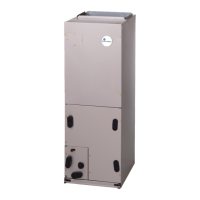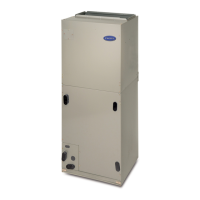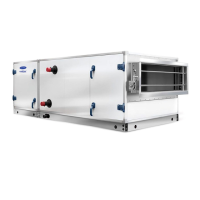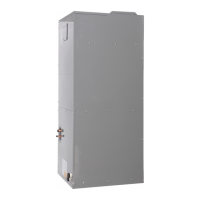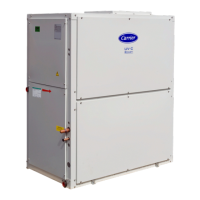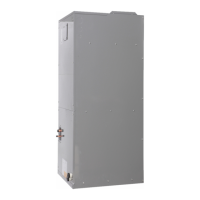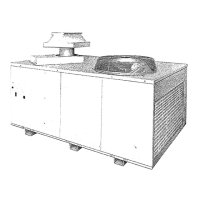58
DEMAND LIMIT CONTROL
Demand Limit Control may override the cooling algorithm and
clamp or shed cooling capacity during run time. The term Demand
Limit Control refers to the restriction of the machine capacity to
control the amount of power that a machine will use. Demand lim-
it control is intended to interface with an external Loadshed
Device through CCN communications, external switches, or 4 to
20 mA input.
The control has the capability of load-shedding and limiting in
3 ways:
• Two discrete inputs tied to configurable demand limit set
point percentages.
• An external 4 to 20 mA input that can reset capacity back
linearly to a set point percentage.
• CCN loadshed functionality.
NOTE: It is also possible to force the demand limit variable (Run
Status
COOL
DEM.L).
To use Demand Limiting, select the type of demand limiting to
use. This is done with the Demand Limit Select configuration
(Configuration
DMD.L
DM.L.S).
To view the current demand limiting currently in effect, look at
Run Status
COOL
DEM.L.
The configurations associated with demand limiting can be
viewed at the local display at Configuration
DMD.L. See
Table 41.
Demand Limit Select (DM.L.S)
This configuration determines the type of demand limiting.
• 0 = NONE — Demand Limiting not configured.
• 1 = 2 SWITCHES — This will enable switch input de-
mand limiting using the switch inputs connected to the
CEM board. Connections should be made to TB202 termi-
nals 1, 2, 3, and 4.
• 2 = 4 to 20 mA — This will enable the use of a remote 4 to
20 mA demand limit signal. The CEM module must be
used. The 4 to 20 mA signal must come from an externally
sourced controller and should be connected to TB202 termi-
nals 10 and 11.
• 3 = CCN LOADSHED — This will allow for loadshed and
red lining through CCN communications.
Two-Switch Demand Limiting (
DM.L.S = 1)
This type of demand limiting utilizes two discrete inputs:
• Demand Limit Switch 1 Setpoint (D.L.S1) — Dmd Limit
Switch Setpoint 1 (0 to 100% total capacity)
• Demand Limit 2 Setpoint (D.L.S2) — Dmd Limit Switch
Setpoint 2 (0 to 100% total capacity)
The state of the discrete switch inputs can be found at the local
display:
• Inputs
GEN.I
DL.S1
• Inputs
GEN.I
DL.S2
The following table illustrates the demand limiting (Run Sta-
tus
COOL
DEM.L) that will be in effect based on the logic of
the applied switches:
4-20 mA Demand Limiting (
DM.L.S = 2)
If the unit has been configured for 4 to 20 mA demand limiting,
then the Inputs
4-20
DML.M value is used to determine the
amount of demand limiting in effect (Run Status
COOL
DEM.L). The Demand Limit at 20 mA (D.L.20) configuration
must be set. This is the configured demand limit corresponding to
a 20 mA input (0 to 100%).
The value of percentage reset is determined by a linear interpola-
tion from 0% to “D.L.20”% based on the Inputs
4-20
DML.M input value.
The following examples illustrate the demand limiting (Run Sta-
tus
COOL
DEM.L) that will be in effect based on amount of
current seen at the 4 to 20 mA input, DML.M.
CCN Loadshed Demand Limiting (
DM.L.S = 3)
If the unit has been configured for CCN Loadshed Demand Limit-
ing, then the demand limiting variable (Run Status
COOL
DEM.L) is controlled via CCN commands.
The relevant configurations for this type of demand limiting are:
• Loadshed Group Number (SH.NM) — CCN Loadshed
Group number
• Loadshed Demand Delta (SH.DL) — CCN Loadshed De-
mand Delta
• Maximum Loadshed Time (SH.TM) — CCN Maximum
Loadshed time
The Loadshed Group Number (SH.NM) corresponds to the load-
shed supervisory device that resides elsewhere on the CCN net-
work and broadcasts loadshed and redline commands to its asso-
ciated equipment parts. The SH.NM variable will default to zero,
which is an invalid group number. This allows the loadshed
function to be disabled until configured.
Upon reception of a redline command, the machine will be pre-
vented from starting if it is not running. If it is running, then
DEM.L is set equal to the current running cooling capacity (Run
Status
COOL
C.CAP).
Upon reception of a loadshed command, the DEM.L variable is
set to the current running cooling capacity (Run Status
COOL
C.CAP) minus the configured Loadshed Demand
Delta (SH.DL).
A redline command or loadshed command will stay in effect until
a Cancel redline or Cancel loadshed command is received, or until
the configurable Maximum Loadshed time (SH.TM) has elapsed.
HEAD PRESSURE CONTROL
Condenser head pressure for the 48/50P Series is managed direct-
ly by the ComfortLink controls. The controls are able to cycle up
to 6 stages of outdoor fans to maintain acceptable head pressure.
Fan stages will be turned on or off in reaction to discharge pres-
sure sensors with the pressure converted to the corresponding sat-
urated condensing temperature.
The head pressure control stages fixed speed fans and modulating
fans, if available, to maintain the head pressures of circuit A and
circuit B within acceptable ranges. For controls purpose, the head
pressures are converted to saturated condensing temperatures
(SCTs) as the feedback information to the condenser fans (also re-
ferred to as “outdoor fans”). SCT.A is the saturated condensing
temperature for refrigeration Circuit A, and SCT.B is the saturated
condensing temperature for refrigeration Circuit B.
There are a total of up to 6 condenser fans (depending on unit size
and installed options) for controlling the head pressures of the 2
refrigeration circuits, of which up to 4 fans can be controlled by
each VFD (Variable Frequency Drive) upon installation option.
The head pressure control described in this document is also re-
ferred to as condenser fan control.
Switch Status Run Status
COOL
DEM.L = 1
Inputs
GEN.I
DL.S1 = OFF
Inputs
GEN.I
DL.S2 = OFF
100%
Inputs
GEN.I
DL.S1= ON
Inputs
GEN.I
DL.S2 = OFF
Configuration
DMD.L
D.L.S1
Inputs
GEN.I
DL.S1= ON
Inputs
GEN.I
DL.S2 = ON
Configuration
DMD.L
D.L.S2
Inputs
GEN.I
DL.S1= OFF
Inputs
GEN.I
DL.S2 = ON
Configuration
DMD.L
D.L.S2
D.L.20 = 80% D.L.20 = 80% D.L.20 = 80%
DML.M = 4mA DML.M = 12 mA DML.M = 20mA
DEM.L = 100% DEM.L = 90% DEM.L = 80%

